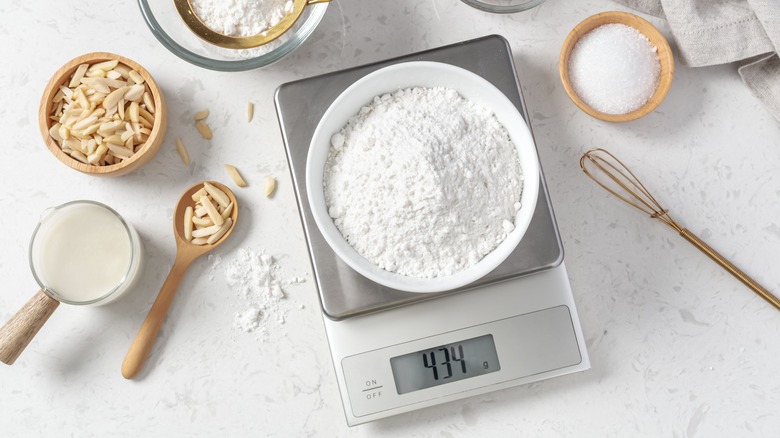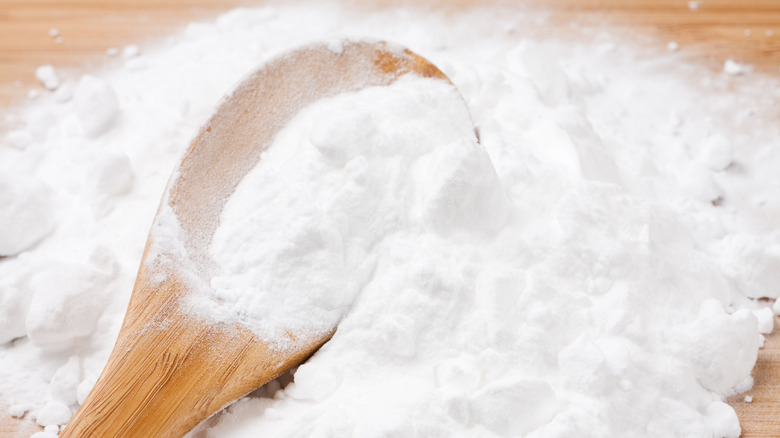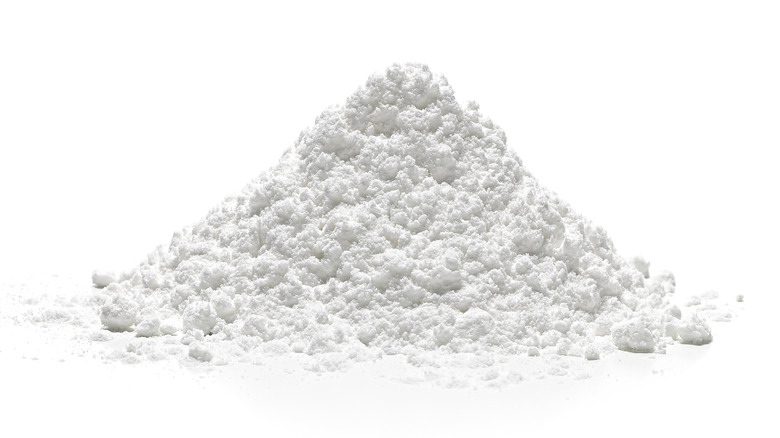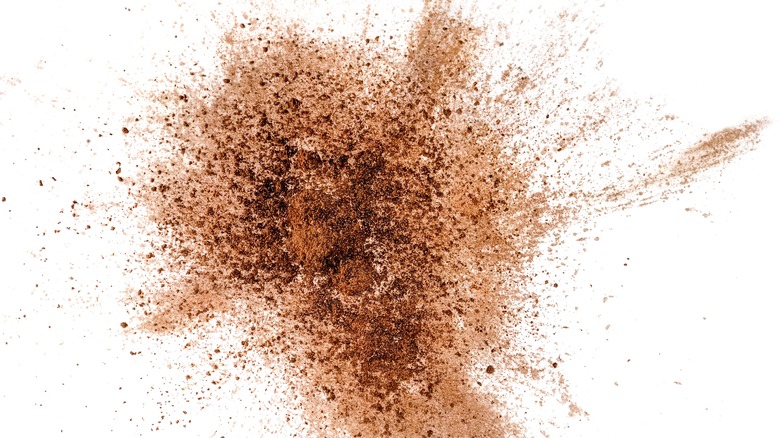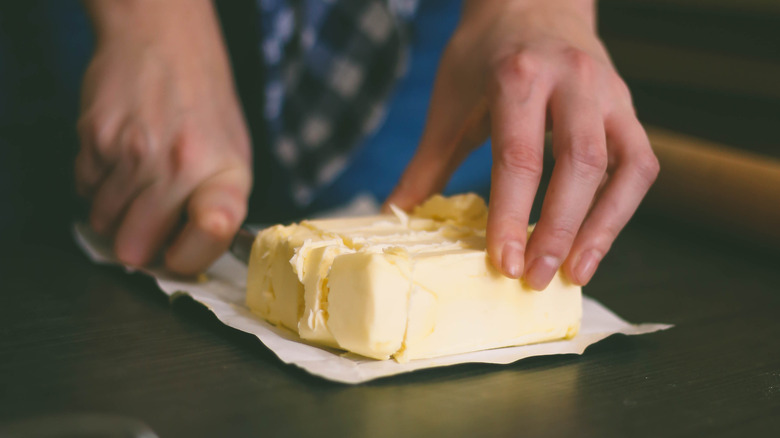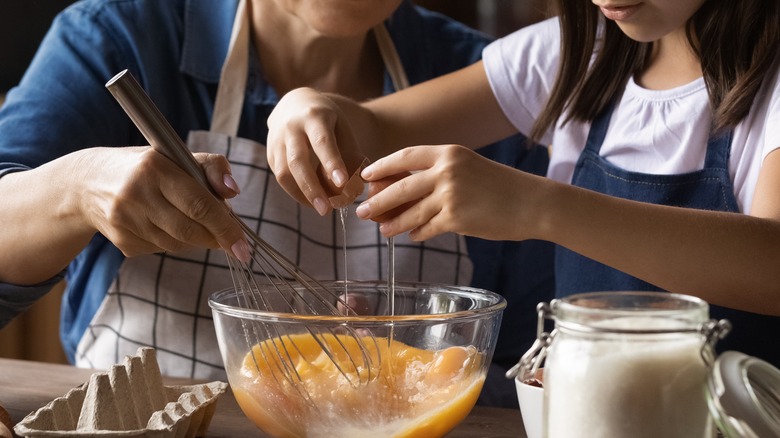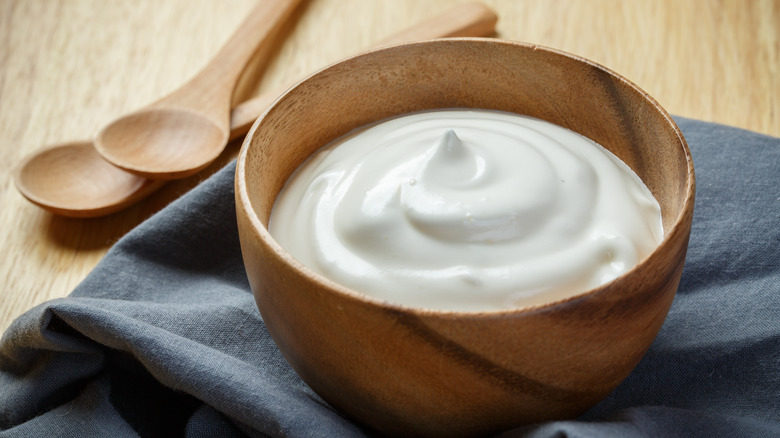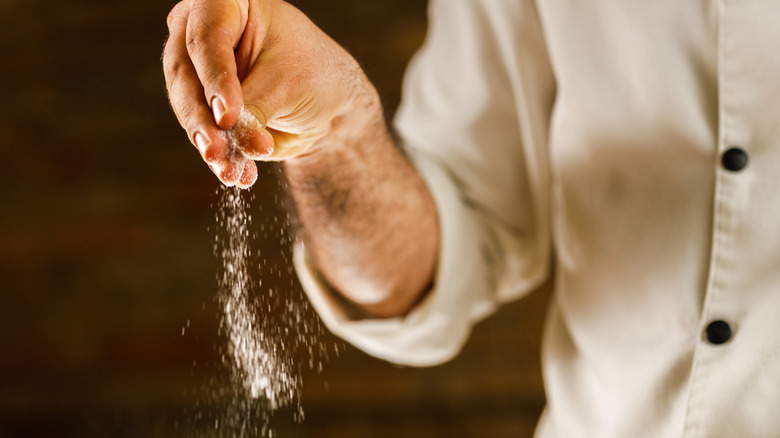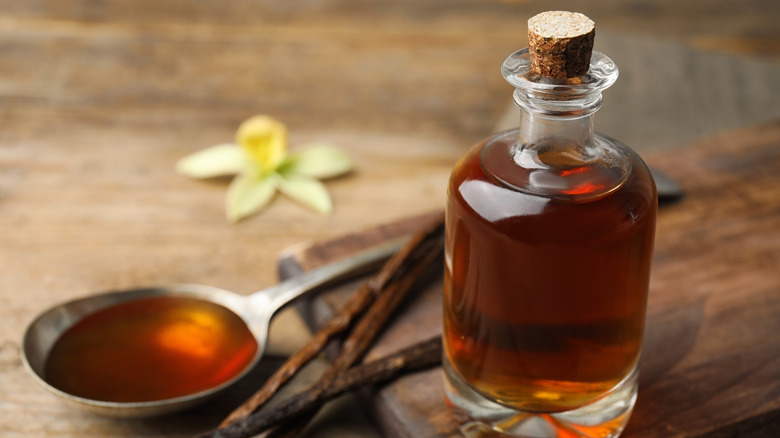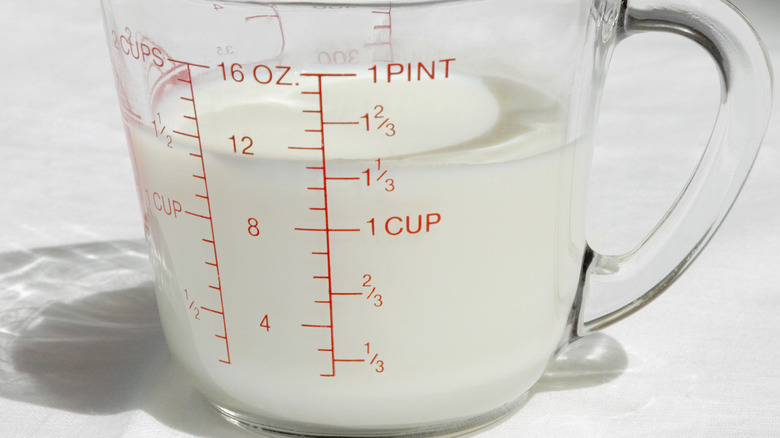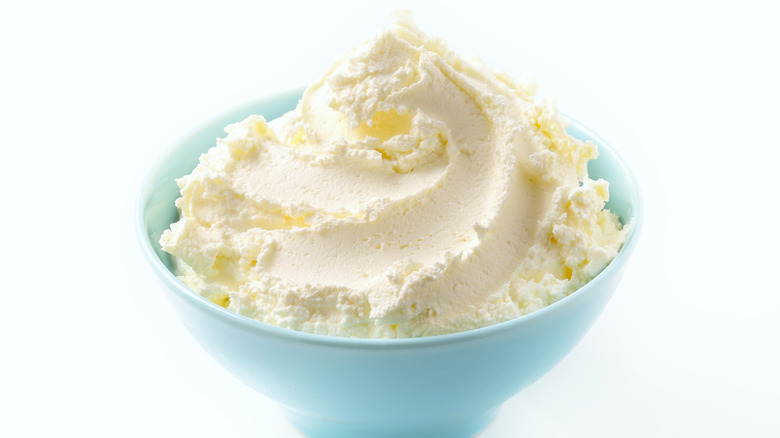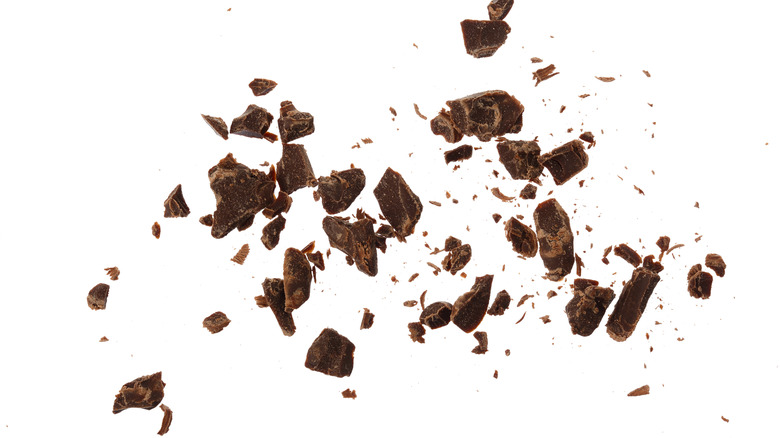The Best Ways To Measure 20 Important Baking Ingredients
Baking is all about the art of precision. Unlike cooking, which can often be done with the loose guidance of a recipe, baking requires exact measurements and attention to detail. If you find that your cakes aren't rising to the occasion or your pizza crust always comes out too dry when you shape it, you should always take a step back and examine if you followed the recipe correctly — in terms of the amount of each ingredient to use when to add it, and how to mix it.
Although there are a ton of different measuring implements out there, like cups, spoons, and scales, the proper way to measure each baking ingredient depends on the item itself. We've done the legwork and researched the best ways to measure essential baking ingredients and any preparation you need to do as a baker to ensure that your measurements are in line with the recipe.
Flour
Flour is the base for almost any bake in the kitchen, from sourdough bread to cookies. If you use too much of it, your bake may come out with dry spots. Skimp on the flour, and you risk other ingredients taking over.
Although the cookies you made with your grandma in the kitchen as a kid were made by scooping from the bag or container, it's not the way you should be properly measuring flour. Since this ingredient tends to stick or aerate easily, scooping your measuring cup into the bag and leveling it will not give you an accurate amount of flour. Forcefully scooping the powder can compress it, and add 30% to 50% more of the ingredient than you intended. The best way to add flour to your recipe is by using a digital scale. One cup of flour weighs between 120 to 130 grams, so you can do the math conversion to make your recipe into weight rather than cups.
If you're baking a recipe, you'll also want to fluff (not sift) your flour before measuring it. Fluffing flour before baking is so important because it makes the ingredient less dense. All you have to do is mix the flour gently with a spatula or spoon until it looks soft rather than compressed.
White granulated sugar
Sugar is an integral component of sweet recipes and icings. But if you mistakenly use too much sugar in a recipe, you can make your scones or layer cake too sweet. Adding too much or too little sugar can also skew the browning process.
Before measuring your sugar, you'll need to mix it to remove any clumps. Properly storing your ingredient in an airtight container will also help prevent moisture encroachment and stop clumping from happening in the future. Then, dip your measuring cup into the sugar container, scoop up your desired amount, and use the back of the knife to level it. Avoid pressing or digging into any side of the measuring cup to prevent losing too many granules. If you're using a scale, assume 1 cup of standard white sugar weighs 215 grams.
Brown sugar
Brown sugar is a little more difficult to measure because it contains molasses, making it flavorful and sticky. To make it even more complicated, recipes often call for different levels of packing with descriptors like "gently" or "firmly." The most precise way to measure this ingredient, since there is so much variance in packing terminology, is to use a scale. One cup of "firmly packed brown sugar" weighs 7.5 ounces (216 grams) for light brown sugar, and 8.5 ounces (240 grams) for dark brown sugar (which contains more molasses). "Packed" or "lightly packed" brown sugar weighs about 7 ounces (200 grams) and 6.5 ounces (185 grams), respectively.
If your recipe doesn't come with weights, you can pack and measure it yourself. To correctly pack your cup of brown sugar, scoop it up in a measuring cup. Then, use the back of a spoon to compress the granules down. When you finish packing and adding more as needed, the sugar should be flush with the cup's rim.
Baking powder and baking soda
Many folks underestimate the importance of correctly measuring chemical leaveners like baking soda and baking powder. After all, if you add a teaspoon instead of a tablespoon of the powder, your baked good will inevitably come out flat, sad, and disappointing.
Before you measure your baking soda or baking powder, give the container a little shake to break up any chunks. Then, use a measuring spoon and a knife (or the flat edge of the container) to flatten the spoon to level it before adding it to your recipe. Although using a scale would be more accurate, most recipes require such a small amount of leavener that it would be a hassle to have to weigh it out, only to have to scoop most of it back in the container when you accidentally pour too much.
Confectioner's sugar
Confectioner's sugar, or icing sugar, has a smaller granule size than standard white sugar and often contains cornstarch. Instead of scooping the powder directly from the container and risking compacting it, use a spoon to transfer the sugar from the bag into the measuring cup. Avoid tapping the sugar down or packing it. Then, use the back of a knife to level the scoop off.
You only need to sift the confectioner's sugar if the recipe requires it — such as for buttercream or whipped cream frosting. To ensure your measurement is correct, carefully read when to sift the ingredient. "X cups of sugar, sifted" would mean sifting it after measuring, while "x cups of sifted sugar" means always sifting before measuring.
Cocoa powder
Cocoa powder is a troublesome ingredient to measure because it always manages to clump up. You should use the same technique for scooping cocoa powder as you would a confectioner's sugar. Scoop the powder from the container with a spoon rather than the measuring implement itself. You should also read the recipe to determine if (and when) you need to sift this notoriously clumpy ingredient.
Not only is the amount of cocoa powder important but also the type of powder you use for your recipe. Natural cocoa powder is acidic, so it will react with baking soda and produce a greater rise in your baked goods. Dutch process cocoa has a more complex flavor and is suitable for baking if there is another acidic ingredient, like lemon juice or buttermilk, to help boost the crumb.
Liquid oils
Liquid oils, such as vegetable or canola oil, should always be measured in a liquid measuring cup. Although both liquid and dry measuring cups hold the same volume of an ingredient, the liquid cups allow the baker to see the bottom of the meniscus (the curve of a liquid). In a dry measuring cup, you're just filling it until it reaches the rim of the cup — or inevitably spills over.
To ensure you're measuring your oil correctly, you're going to want to place the cup on a flat surface and look at the side of the cup. Pour until the bottom of the meniscus is in line with the measurement you need. If you're measuring a trivially small amount of oil, such as a tablespoon or two, a measuring spoon will suffice.
Butter
Butter companies have made it easy for bakers to determine how much of a stick of butter they'll need for a recipe. Most commercial butter contains labels on the side; each stick is 8 tablespoons or ½ cup. The lines on the stick denote each tablespoon. One "pat" of butter typically refers to a single tablespoon.
European butter, like Kerrygold, does not have these notations. Typically, the packages are sold in 1 or 2-cup blocks. If you're working with these kinds of butter, always reference the package to determine the most accurate weight. You can also use a scale to measure your butter. Two sticks of butter (1 cup) weigh about 227 grams or 8 ounces. You should avoid using a measuring cup for your butter because its stick shape will never yield an accurate measurement.
Eggs
Most recipes just ask for a certain amount of eggs — without reference to size or type. So, how do you determine if you're using enough eggs for your recipe?
Some recipes will use the terminology "large," "extra large," or "jumbo." These refer to the weights of a dozen eggs. By the USDA's Guidelines, a "large egg" is 2 ounces or would be sold with a minimum weight of 24 ounces per dozen. However, since the size requirement only applies to a dozen eggs, the actual weight of each egg may not be the same. Extra-large eggs weigh 27 ounces per dozen, while jumbo eggs are 30 ounces.
Besides the weight of the carton, the measurement for these eggs also includes eggshells. For the absolute most precise measurement, you should estimate each egg weighing about 1.73 ounces, 0.54 ounces for the yolk, and 1.19 for the white. You can use your kitchen scale for this, or when baking with eggs, assume the recipe calls for a large egg unless otherwise specified.
Semi-liquids
"Semi-liquids" are an ambiguous class of their own and refer to ingredients that have both liquid and solid properties. They might include peanut butter, sour cream, applesauce, and yogurt.
Since these liquids are too thick to measure with fluid measuring cups, opting for a dry scoop is your best bet. Scoop the ingredient into the cup and use a spatula or knife to level it out. Then, scrape out the cup into your mixing bowl of choice. If you're working with a particularly sticky ingredient, try adding a layer of plastic wrap to the inside of the cup for an easy release.
One ingredient within this class that is particularly difficult to measure is mashed banana. Most recipes will note "x bananas, mashed," meaning that you should measure the whole banana before mashing it. Two medium bananas equal about a pound of diced bananas, while three medium bananas will make about 1 cup of mash.
Dry yeast
We can't underscore the importance of correctly measuring your yeast for bread making. One standard yeast packet holds about 2 ¼ teaspoons of yeast or about ¼ of an ounce. If your recipe requires less than a packet, or you're taking from a larger container, you should measure the granules like baking soda or baking powder. Since the particles are small, measuring using a scale is a wash.
Bread bakers should know the difference between each type of yeast. Fresh yeast and dried yeast are interchangeable in a recipe, with the former being a favorite because of its more defined flavor and high activity levels. However, to prepare fresh yeast (or cake yeast) for a recipe, you'll need to portion it out before dissolving it in a liquid. Active dry yeast, in comparison, is in a powder that can be poured directly into your dough.
Oats
You wouldn't have oatmeal cookies without oats. To measure this grain for your recipe, you'll first want to check the recipe for the type of oat you'll need. Old-fashioned oats are larger in size than quick-cook oats. You can transform your old-fashioned oats into quick-cook oats by adding them to a food processor and pulsing them until they resemble a coarse, powdery consistency.
Regardless of the type of oat your recipe requires, you'll need to spoon the oats into your measuring cup and level it with a knife before folding it into your recipe. Although oats won't necessarily compact the same as flour or confectioner's sugar, this method is still the most effective way to ensure you're not packing your oats into the cup.
Salt
What is a "pinch of salt" anyway? It's a question that has puzzled bakers and chefs for many years, but this seemingly careless measurement actually does have a numerical equivalent — and it's not the same as a "dash of salt," either.
"Add a pinch" generally refers to about 1/16 of a teaspoon — or about the amount you can hold with your thumb and your forefinger. Using these two fingers rather than multiple is important because then you could add as much as ⅛ teaspoon (or a "dash") of salt. A "tad" is ¼ teaspoon, while the much less popular "shake" is around 1/32 of a teaspoon.
If your recipe requires any more salt than these ambiguous measurements cover, always use a measuring spoon and level it with a knife before pouring it in. Like other ingredients, avoid pouring the salt directly over the mixing bowl — as you could end up with very salty cookies.
Extracts
Extracts are an easy way to add flavor essence to your recipe. The most popular ones include vanilla, orange, and almond — but you might also see odd ones like maple, banana, and even root beer. Since extracts are very potent liquids comprised of flavoring and alcohol, measuring them with intent and discretion is vital to ensuring the flavors of your recipe are balanced. After all, cookies with 1 tablespoon of almond extract taste very different from cookies with a teaspoon.
You'll want to use measuring spoons to portion out your extracts accurately. Like salt, it's very important not to pour the extracts over the bowl. Instead, we recommend pouring over a clean container. That way, you can return any spilled extract (especially the expensive ones, like vanilla) back into the bottle.
Milk and cream
Liquid dairy products like milk, cream, half-and-half, and buttermilk should always be measured in a liquid measuring cup. Like oils and other liquid ingredients, you should always place the cup on a level surface and pour facing the side of the cup to ensure that it is level with your desired mark on the cup.
One of the biggest mistakes bakers make when measuring their liquid ingredients on a scale is using the fluid ounces setting rather than just the ounces setting. The two are not interchangeable because fluid ounces are a measure of volume, while ounces (or grams) are a measure of mass. If you have a recipe with the liquid measured in ounces, you should assume it refers to fluid ounces. However, if the recipe lists all of its ingredients with weights before volume, like 100 grams of flour and 200 grams of water, you should use the appropriate gram (weight) function on your scale.
Cream cheese
There wouldn't be a cream cheese frosting recipe without this critical ingredient. Cream cheese is often purchased in a solid brick, making measuring it easy. However, numerous tricky bends may throw your recipe off if you aren't careful.
The first major discrepancy with cream cheese is that whipped (aerated) cream cheese and blocks of cream cheese aren't the same. As a result, whipped cream cheese will always weigh less per unit of volume than blocks of cream cheese. One cup of cream cheese weighs 8 ounces, while a cup of whipped cream cheese weighs 6.4 ounces. In reading a recipe, you should use the specific type of cream cheese recommended. Some recipes, like cheesecake, cannot interchangeably use the two without altering the dessert's texture. Both kinds of cream cheese should be measured like a semi-liquid — by scooping and leveling it.
Citrus juice
No one ever explained how much juice is in a lemon, so we admittedly have been living our lives without any sort of security in our lemon bar recipe. The amount of juice in a lemon varies based on its size and how it's prepared.
On average, a lemon contains about 3 tablespoons of juice, while a lime contains around 2 tablespoons. Very large lemons can contain upwards of 5 ounces of juice, so it's important to try to find standard-sized lemons, which are about 4 to 5 ounces with the peel on, to make your recipe if you're going by the ambiguous "juice of one lemon." You can purchase a twist juicer with measurements on the side of the container to ensure you're getting the exact amount of juice you need.
Spices
Spices are an easy way to take the flavor of your favorite recipes up a notch. For most recipes, you're only using teaspoons or tablespoons, so you'll need to have a set of measuring spoons on hand. Some recipes using trivially small amounts of ingredients, such as a pinch or a sprinkle, may require you to use some judgment to determine how much to add.
It's also very important to remember that interchangeably using dried and fresh herbs and spices will alter the taste and texture of your baked goods. For example, before substituting dried herbs for fresh ones, it's important to know that you should only use about a teaspoon of dried herbs for each tablespoon of fresh ones. You'll also need to alter the timing of adding these ingredients depending on the type you're using.
Chocolate
Chocolate is an example of just one ingredient you can add to make your cookie, muffin, or brownies extra special. But getting the right amount of chocolate for your recipe can be tricky, especially considering chocolate chips do not conform to a measuring cup. For any odd-shaped ingredients, including chocolate, dried fruit, and nuts, the best method of measurement is to use a kitchen scale.
Place the bowl on the scale and tare the weight. You can assume that each ounce of chocolate is 24 grams, but each cup depends on the size of the chip. For the standard chocolate chip, 1 cup is about 6 ounces or 170 grams. Bars of chocolate are typically 1 ounce per square, but you can confirm on the packaging before you use it.
Shortening and lard
Shortening and lard are common replacements for butter in baking. The easiest way to measure shortening is to purchase the sticks of it with the measurements listed on the side of the package. Then, you can slice off as much as you need, just like butter.
However, not all shortening comes in convenient sticks. Most people will have to use a scale or a measuring cup for their recipe. You can assume that one cup of shortening weighs about 184 grams,while 1 cup of lard weighs 205 grams. If you're sticking with the measuring cup, always press out the air pockets in the shortening or lard using the back of a spoon to ensure your measurement is even and accurate. When it's time to remove the shortening or the lard, push it out using a knife or sturdy spatula.
Static Media owns and operates Tasting Table and Mashed.

